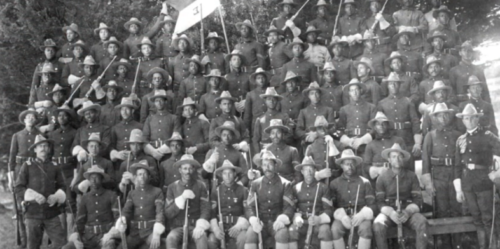Recently I found out blacks invented mountain biking in America. In that history I found multiple references to Buffalo Soldiers being the first park rangers in America. 
In 1869, Congress established four all-black regiments within the Army – the 9th and 10th Cavalry and the 24th and 25th Infantry. These soldiers, known for their fierce bravery and fighting spirit, were dubbed “Buffalo Soldiers” by Native Americans during the American Indian Wars.
All four of the first regiments of “Buffalo Soldiers” were garrisoned right here in the Presidio during the Spanish-American (1898) and Philippines-American War (1899-1902). There are 450 Buffalo Soldiers interred at the Presidio’s San Francisco National Cemetery.
Buffalo Soldiers protected parks in the western United States before the National Park Service was created. The Presidio’s 24th Infantry and 9th Calvary units protected both Yosemite and Sequoia national parks in 1899, 1903, and 1904.
Here’s a video posted by Presidio Park in July 2020 that gives more detail to the story as told by Rik Penn, a black park ranger working there now:
It has 405 views.
And here’s even more history from Presidio Park that has ONLY 78 VIEWS!
The commander of “I” Troop was Captain Charles Young, the only African American troop commander in the regular army. A man of many talents, Young was the only Black graduate of West Point still serving in the army.
Life changed for the 3rd Squadron in April and May of 1903, when it was assigned two special missions. On April 23rd the squadron was divided, and Troops K and L were dispatched to Wawona, California, at the southern boundary of Yosemite National Park. Their mission was “to establish a camp with the purpose of protecting the Park from injury and depredations.” These black troops spent the entire season patrolling and maintaining the national park.
Captain Young and the men of I and M troops remained at the Presidio for one last duty before being dispatched to patrol Sequoia National Park. Their duty was to serve as special escort to the President of the United States, Theodore Roosevelt, on his West Coast tour of California. The President visited San Francisco on May 12th through 14th. Thousands of people turned out to greet the Chief Executive.
Accompanying the President through the streets of San Francisco were Buffalo Soldiers on horseback flanking several carriages of honored guests. Captain Young was attired in his dress blues; the soldiers were resplendent wearing their neat but simple blue uniforms with a pill box cap, white canvas leggings and gloves.
The troops provided not only an escort and security for the distinguished guest, but also served as “Guard of Honor.” The San Francisco Call lauded Troops I and M as two “crack military organizations that had the honor of forming Roosevelt’s escort.”
For many of these men, the escort duty had been a reunion of sorts, having last seen “Colonel” Roosevelt on the crest of San Juan Hill in 1898. Although Roosevelt had praised the Black soldiers shortly after the battle, he had since incensed them by making disparaging remarks about their worth as professional soldiers in Scribner’s magazine.
The use of the 9th U.S. Cavalry to provide his escort may have been seen by some as an apology of sorts. Having Captain Young as I Troop commander certainly gave the President a first-hand look at a Black man who was a competent commander and troop leader.
I’ve spent decades in and around the Presidio, I study black history constantly, and yet this is all news to me.